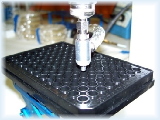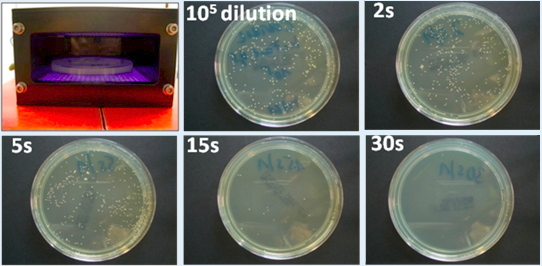| |
|
|
|
|
|
|
Plasma Biology
 Back to Plasma Biology
Back to Plasma Biology
 Low-temperature atmospheric-pressure plasma is a multi-component system that
includes such biologically active agents as charged particles, reactive
nitrogen and oxygen species, metastable-state molecules or atoms, and UV
radiation. The major goal of our research is to investigate the effects of
these plasma components, separately and in different combinations, on bacteria,
viruses, and different types of human cells. This knowledge would provide a
basis for designing purpose-specific plasmas for biomedical applications.
Low-temperature atmospheric-pressure plasma is a multi-component system that
includes such biologically active agents as charged particles, reactive
nitrogen and oxygen species, metastable-state molecules or atoms, and UV
radiation. The major goal of our research is to investigate the effects of
these plasma components, separately and in different combinations, on bacteria,
viruses, and different types of human cells. This knowledge would provide a
basis for designing purpose-specific plasmas for biomedical applications.
1. Bactericidal and antiviral effects of plasma irradiation
Bactericidal and antiviral properties of plasmas have been intensively
studied and utilized for the decontamination and sterilization of medical
instruments, catheters, packages, containers and premises. The main difference
of plasmas developed in our group from the plasmas used for surface sterilization
is that our plasmas are designed for the disinfection of living tissues (e.g.
skin and chronic wounds). In order to avoid damaging human cells and tissues,
these plasmas should have low temperature (<37°C), low-intensity of UV
radiation, and low, micromolar concentrations of reactive species. To identify
the sterilizing potential of these ''low-intensity'' plasmas, we are currently
testing the effects of plasma irradiation on gram-positive (Enterococcus
mundtii and methicillin-resistant Staphylococcus aureus (MRSA))
and gram-negative (Escherichia coli and Pseudomonas aeruginosa)
bacteria, bacterial spores, pathogenic fungi (Candida albicans), and
adenoviruses. Additional experiments include control for the development of
plasma resistance and antibiotic resistance in several consequent generations
of bacteria which survived the plasma treatment.

Figure 1: Effect of irradiation with air plasma on methicillin-resistant
Staphylococcus aureus (MRSA). Four agar plates (the bottom of the picture)
were inoculated with approximately 107 bacteria/plate, exposed to plasma
produced by the plasma dispenser (the top left picture) for 2s, 5s, 15s and 30s and
consequently incubated during 18 hours at 35°C, so that the survived bacteria
could reproduce and form colony forming units (CFUs). The number of CFUs corresponds
to the number of bacteria, which survived the plasma treatment. For comparison, a
control plate containing a 105 dilution of the bacterial inoculate is
included (the top right picture). From the results it is clearly visible, that the
bactericidal effect of the plasma increases for larger plasma treatment times.
Only five seconds of plasma irradiation caused over five orders of magnitude
reduction in the MRSA load.
Read more:
- Effects of plasma irradiation on
human cells
 Top of page
Top of page
|
|
|
|
| |
|
|